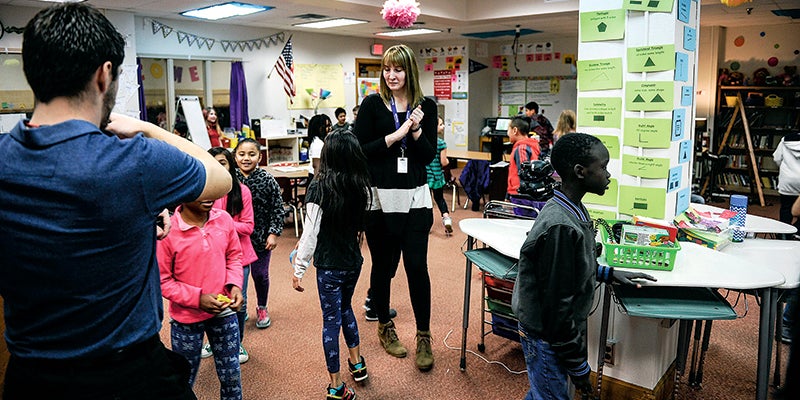A different approach: Austin looking at long-term approach to retaining teachers
Published 1:01 pm Sunday, April 2, 2017

- Caitlin Haugland walks through the third-grade pod room as students prepare for a class activity. Eric Johnson/photodesk@austindailyherald.com
Austin Public Schools use a variety of methods to attract teachers, but any long-term solution, said Human Resources Director Mark Raymond, “is out of our control right now.”
Attracting college students to the profession is the biggest challenge, he said.
“We need to increase the number of students coming into the profession” to make significant and enduring impacts.
“The root problem is availability; if you have 15 positions open and only 10 teachers, you have five spots that aren’t going to be filled, no matter what you do,” Raymond said.
A beginning teacher’s salary of $40,000 can be attractive if you have no debt.
“But if you’re coming to a $40,000 job with $100,000 of college debt … that might be pretty hard,” he said.
But even more than that, he added, “I think a lot of students want professional respect; and to be honest, education as a whole has lost a bit of its luster in recent years”
There are several initiatives, however, that Austin is using to encourage and retain instructors, he said. One way is to simply start hiring earlier, beginning in March instead of the traditional April.
Another is to work harder to retain young teachers, who record the highest number of drop-outs from the profession in the first five years on the job. Some have little support or few resources to make the job attractive enough to stay in some schools, he added.
Austin, Raymond said, is increasing the size and scope of its mentorship program, “making it a fundamental part of a teacher’s first three years in the profession. It will be far more comprehensive” than the current program.
High shortage areas — English Learners (EL) and special needs — are also being addressed with providing financial help for those teachers wanting to obtain certification in those areas. They can either pay the funds back in to the district upfront, or forego the additional money earned through lane changes until the debt is paid. A change in lanes, reflected on the salary schedule, brings a higher salary with additional college credit hours of study.
Perhaps the most significant change in Austin to address the shortage has been the establishment of a new elementary teacher prep program. This spring, 24 new elementary teachers will be the first graduation class of a new teacher prep program that partners Austin High School, Riverland Community College and Winona State University in a unique fashion. Another 10 students are in the program’s junior class.
The enhanced “grow your own” elementary teacher education program is tailored just for Austin, offering two years of study for a student’s associate degree at Riverland before transferring directly to WSU to complete a degree for a bachelor of science degree in teaching education. While that concept is nothing new — many community and four-year colleges have similar agreements — this innovation is unique. All of the classes, clinical experiences and other training are done almost exclusively in Austin, The classroom is located at Sumner Elementary School.
The last two years are filled with clinicals and in-classroom training — a training many college students do not get until the spring of their senior year.
Many in the pool are non-traditional students, primarily from Austin, or nearby. Some are paraprofessionals who already work in the classroom setting; others are mid-career students who have chosen to switch to education.
“I think, altogether, we’re supposed to have 160 hours of training in the classroom — but I know it’s even more than that,” said soon-to-be-a-graduate, Caitlin Haugland in February. “And we cannot believe how lucky we are to be part of this.”
Students have participated in external clinicals that took them to other schools in the district, so that by the time each graduate, they will be have worked with at least six or seven other instructors. By the end of this year, the program’s seniors will have worked with 45 different Austin teachers over their coursework, according to Dr. Debra Mishak, assistant professor from WSU who is also the coordinator of the 2+2 program.



